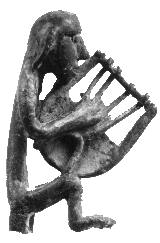| |

Sample
Demodokos' song about Ares and Aphrodite: Od. 8, 267-366:
 Real Player Real Player
 MP3 File (Just the beginning of the song: Od. 8, 267-299, 2.4 MB) MP3 File (Just the beginning of the song: Od. 8, 267-299, 2.4 MB)
 WAV-File (Just the very first lines: Od. 8, 267-273, 811KB) WAV-File (Just the very first lines: Od. 8, 267-273, 811KB)
Bibliography
- M. L. West, The singing of Homer and the modes of early Greek music, Journal of Hellenic Studies 101 (1981), 113-129. [General considerations; the tuning of the phorminx (but see: Ancient Greek Music, Oxford 1992, 328). The given melodies do not conform to our theory.]
- G. Danek, 'Singing Homer'. Überlegungen zu Sprechintonation und Epengesang, Wiener Humanistische Blätter 31 (1989), 1-15. [General considerations. The given melodies do not conform to our theory.]
- S. Hagel, Zu den Konstituenten des griechischen Hexameters, Wiener Studien 107/108 (1994), 77-108. [Statistics, general melodic contours]
- A. M. Devine / L. D. Stephens, The Prosody of Greek Speech, New York / Oxford 1994. [Indispensable for everyone interested in Ancient Greek accent]
 G. Danek / S. Hagel, Homer-Singen, Wiener Humanistische Blätter (1995), 5-20. [The novice's first guide] G. Danek / S. Hagel, Homer-Singen, Wiener Humanistische Blätter (1995), 5-20. [The novice's first guide]
- S. Hagel / G. Danek, Computergestützte Hexameter - Hexametersingender Computer, SIMA 2 1996 111-122. [Technical background]
- G. Danek / S. Hagel, Das Geheimnis der Lieder Homers - mit dem Computer entschlüsselt, Kremser Humanistische Blätter 3 1999, 47-55.
Homeric Singing - Abstract
- Epic performance was originally sung, in Ancient Greece (Demodokos!) as well as in many other traditions. The Greek aoidoi sang ro the accompaniment of the lyre (phorminx).
- The performance of Ancient Greek verse, as heard today, which involves the so called ictus that overrides the word accents, is far removed from ancient pronunciation in several respects.
- Ancient Greek had a pitch accent, that is, the accent was expressed by means of pitch contour, not of stress.
- Extant settings of ancient music show that in traditional non-strophic poetry the melody followed the accentual contours.
- Thus, the melodies of early Greek hexameter poetry are not unlikely to have been governed by word accent and sentence intonation.
- There is statistical proof that end-accented words are avoided at caesura, but favored at metrical bridges. The melody of the 'typical' hexameter fell at the middle caesura as well as at the end of the verse. The 'typical' melodic contour consisted of a double, sometimes triple rise and fall.
- Less common verses have deviant melodic contours. E.g., in cases of strong enjambement, when the sentence lacks completion at verse end, we encounter a rising contour in the last third of the verse which lacks its completion by a melodic fall. Sentence and melodic trajectory are completed in the next verse.
- These results give rise to a technique of Homeric performance which can be acquired. The performer has to accommodate the accentual rises and falls of the individual words of each verse to the melodic contour which results from syntactical and metrical features. With some training, anyone who is able to read Homer can learn to improvise the melody to any given Homeric text.
- Individual accents produce smaller deviations from the overall melody (as in the extant musical documents). Each (major) accent may be realized by a rise to the accented syllable, but must be followed by a melodic fall. In the case of circumflex syllables, the post-accentual fall may be realized on the second part of the accented syllable, resulting in a two-note 'melisma'. The gravis accent forces the melody to rise without any downtrend up until the next accented syllable.
- Greek hexameter poetry is stichic. Enjambement should not by expressed by shortening or skipping the pause/instrumental interlude between the verses, but only by means of melody. On the other hand, pauses within the verse are incompatible with Greek versification.
|

Blind singer
Cretan geometric bronze figurine
Malibu
|




